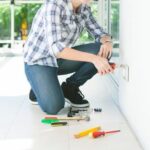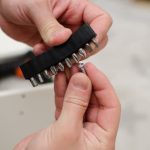A cool and comfortable home environment is essential for our overall well-being and quality of life. As the summer heat intensifies, finding effective ways to improve cooling in our homes becomes a pressing concern. Whether it’s combating high temperatures or ensuring better airflow, taking steps to enhance the cooling system can make a significant difference in creating a comfortable living space.
In this article, we will explore various strategies and practical tips to improve cooling in your home. We will start by understanding the basics of home cooling systems, including how they work and different options available in the market. Next, we will delve into evaluating and optimizing insulation, highlighting the crucial role it plays in efficient cooling. We will also discuss enhancing airflow and ventilation, as well as utilizing smart thermostats for temperature management.
Additionally, energy-saving tips for cooling and proper maintenance practices will be covered to help you achieve cost-effective and long-lasting results. We will explore alternative cooling methods that complement traditional systems, along with troubleshooting common cooling problems. By the end of this article, you will have a comprehensive understanding of how to create a cool and comfortable home environment that suits your needs while keeping energy consumption in check.
So let’s dive into the different aspects of improving cooling in your home and transform your living space into an oasis of comfort during the hot summer months.
Understanding the Basics of Home Cooling Systems
One of the fundamental steps to improving cooling in your home is to understand how home cooling systems work. By having a basic understanding of these systems, you can make informed decisions when choosing the right cooling system for your home.
Home cooling systems work by removing heat and moisture from the air, creating a cool and comfortable indoor environment. The most popular types of cooling systems include central air conditioning, window units, and ductless mini-split systems. Central air conditioning is suitable for larger homes and provides whole-house cooling through a network of ducts.
Window units are ideal for smaller spaces or individual rooms as they can be installed directly into a window opening. Ductless mini-split systems are versatile and provide efficient cooling without requiring ductwork.
When choosing the right cooling system for your home, it’s essential to consider factors such as the size of your space, energy efficiency ratings, and budget. Larger homes may benefit from central air conditioning, while smaller spaces can be adequately cooled with window units or ductless mini-split systems. It’s also wise to consider energy efficiency ratings to ensure that your chosen system operates efficiently while keeping utility costs down.
By gaining an understanding of how these different cooling systems operate and what factors to consider, you can make an informed decision on which type of system is best suited for your home. Consulting with a professional HVAC technician can also help you determine the optimal solution based on your specific needs and requirements.
Evaluate and Optimize Insulation
Insulation plays a crucial role in achieving efficient cooling in your home. Without proper insulation, cool air from your cooling system can easily escape, making it harder to maintain a comfortable temperature and leading to increased energy consumption. In this section, we will explore the importance of insulation in cooling your home efficiently and provide tips on how to evaluate and optimize insulation in key areas such as attics, walls, and windows.
The Role of Insulation
Insulation acts as a barrier between the indoor and outdoor environments, helping to regulate the transfer of heat. During hot weather, insulation prevents the heat from entering your home, thereby keeping it cool. It also traps the cool air generated by your cooling system inside your home, ensuring that it circulates effectively without escaping through gaps or poorly insulated areas.
Checking and Improving Insulation
To determine if you have adequate insulation in your home, start by checking key areas such as attics, walls, and windows. In the attic, look for any gaps or holes where air might be escaping or entering. Seal these gaps with caulk or use weatherstripping around attic hatches to prevent cool air from seeping out.
When evaluating wall insulation, you may need professional help as it requires accessing interior walls. However, there are signs that indicate poor wall insulation such as drafts near outlets or switches on exterior walls and uneven temperatures between rooms. Addressing these issues might involve adding additional insulation or considering options like blow-in insulation through small holes.
Windows are another area where cool air can escape easily. Check for cracks or gaps around window frames and use weatherstripping or caulking to seal them. Adding insulating window film can also help reduce heat transfer while still allowing natural light to enter.
Utilizing Reflective Insulating Materials
In addition to traditional methods of insulation, consider incorporating reflective insulating materials to optimize cooling in your home. These materials are designed to reflect heat away from your home, preventing it from entering and reducing the workload on your cooling system. Reflective insulation can be installed in various locations such as the attic, roof, or even behind radiators, depending on your specific needs.
By evaluating and optimizing insulation in your home, you can greatly improve its cooling efficiency. Not only will this lead to a more comfortable living environment, but it can also help you save on energy costs by reducing the workload on your cooling system. Next, we will explore strategies to enhance airflow and ventilation for even better cooling performance.
Enhancing Airflow and Ventilation
Proper airflow and ventilation play a crucial role in keeping your home cool and comfortable. Without adequate air circulation, your cooling system may struggle to distribute cool air effectively, leading to areas of the house that are not sufficiently cooled. Fortunately, there are several strategies you can employ to improve airflow and ventilation throughout your home.
One simple yet effective way to enhance airflow is by using fans strategically in each room. Ceiling fans, especially those with adjustable speeds, can help circulate cool air during hot weather. Additionally, oscillating fans or box fans can be placed near windows or in doorways to create cross ventilation and draw in fresh air from outside.
Another key factor in promoting good airflow is keeping doors open between rooms. By doing so, you allow air to flow freely throughout your home without any hindrances. If privacy is a concern, consider installing vents or grilles on doors to enable airflow while still maintaining some level of privacy.
Furthermore, it is essential to have a well-functioning ventilation system in place. This includes exhaust systems in areas such as kitchens and bathrooms where heat and humidity tend to accumulate. Regularly clean filters and vents to ensure they are not clogged with debris or dust that may obstruct airflow.
By implementing these strategies for enhancing airflow and ventilation, you can achieve a more consistent and comfortable cooling experience throughout your home.
Smart Thermostats and Temperature Management
One of the most effective ways to improve cooling in your home is by incorporating smart thermostats into your temperature management system. Smart thermostats offer several benefits, including increased energy efficiency and personalized temperature control. Here are some key points to consider when it comes to smart thermostats and how to efficiently set and program them for cost-effective cooling.
Firstly, it’s important to understand that smart thermostats are devices that can be controlled remotely through an app on your smartphone or tablet. They use advanced technology to learn your habits and preferences, allowing them to automatically adjust the temperature based on your needs. This not only provides convenience but also helps optimize energy usage by avoiding unnecessary cooling when you’re away from home or asleep.
To effectively utilize a smart thermostat for cooling, start by setting temperature ranges that balance comfort and energy usage. It’s generally recommended to set the thermostat at around 78°F (25°C) during the summer months for efficient cooling while still maintaining a comfortable indoor environment. However, keep in mind that optimal temperatures may vary depending on individual preferences and climate conditions.
Another important feature of smart thermostats is their programmable capabilities. Take advantage of these features by programming your thermostat to adapt to different schedules and weather conditions. For example, you can create a schedule that sets the temperature warmer during times when no one is typically at home, such as during work hours or vacations. Additionally, many smart thermostats have geofencing capabilities which use your smartphone’s location to adjust the temperature as you approach or leave home.
Incorporating energy-saving practices into your daily routine is another way to maximize the benefits of using a smart thermostat for cooling. Consider utilizing ceiling fans in conjunction with your air conditioning system since fans can help distribute cool air more efficiently throughout the room. You can also make it a habit to close curtains or blinds during the hottest parts of the day to prevent heat from entering your home.
By utilizing smart thermostats and implementing temperature management strategies, you can achieve more efficient cooling in your home. Not only will this help you stay comfortable during hot summer months, but it will also contribute to lower energy consumption and reduced environmental impact. Take advantage of the technological advancements in heating and cooling systems by upgrading to a smart thermostat for cost-effective and personalized climate control.
Energy-Saving Tips for Cooling
When it comes to cooling your home, energy efficiency is an important aspect to consider. Not only does it help you save on utility bills, but it also reduces the overall environmental impact of your cooling system. In this section, we will discuss practical tips to lower energy consumption while maintaining a cool home.
One of the simplest yet effective ways to save energy on cooling is by setting optimal temperature ranges. The Department of Energy recommends setting your thermostat at 78°F (25°C) during the warmer months when you’re at home and adjusting it higher when you’re away. This balance in temperature will ensure comfort while reducing unnecessary energy usage. Additionally, using fans to circulate air can make the room feel cooler without needing to lower the thermostat.
Incorporating energy-saving practices into your everyday routines can also contribute to a more efficient cooling system. For example, keeping blinds or curtains closed during the day can effectively block out the heat from sunlight, resulting in less strain on your cooling system. Also, avoiding the use of heat-generating appliances such as ovens and dryers during peak hours can prevent unnecessary heating in your home.
| Tips | Description |
|---|---|
| Set optimal temperature ranges | Adjusting thermostat settings for comfort and energy savings |
| Use fans for circulation | A cooler-feeling room without drastically lowering the thermostat |
| Keep blinds or curtains closed | Blocking out heat from sunlight during hot periods of the day |
By implementing these energy-saving tips and strategies, you can enjoy a cool and comfortable home while reducing your energy consumption. This not only benefits your wallet but also contributes to a more sustainable living environment.
Proper Maintenance and Upkeep
Maintaining your cooling system is crucial for its longevity and efficiency. Regular maintenance not only helps you avoid costly repairs but also ensures that your home stays cool and comfortable throughout the year. Here are some essential tips for proper maintenance and upkeep of your cooling system:
- Clean or replace air filters regularly: Dirty or clogged air filters can obstruct airflow, reducing the cooling efficiency of your system. In most cases, you should clean or replace the filters every one to three months, depending on usage. Check the manufacturer’s instructions for guidance on cleaning or replacing filters.
- Keep outdoor units clean: The outdoor unit of your central air conditioning system needs to be free from debris such as leaves, dirt, or grass clippings. Regularly inspect and clean the unit by gently hosing off any buildup on the coils or fins.
- Check refrigerant levels: Improper refrigerant levels can cause your cooling system to work harder than necessary and lead to increased energy consumption. It’s best to hire a professional technician to check and adjust refrigerant levels annually.
- Maintain condensate drain lines: Over time, condensate drain lines can get clogged with algae, mold, or debris, leading to water leaks and reduced airflow. Inspect and clean the drain lines periodically using a mixture of bleach and water or consult a professional if you notice any issues.
- Inspect electrical connections: Loose or corroded electrical connections can disrupt the functioning of your cooling system. Turn off power before inspecting any electrical components and tighten any loose connections if needed.
- Schedule annual professional maintenance: While there are many DIY maintenance tasks you can handle yourself, getting an annual professional tune-up is highly recommended to ensure optimal performance of your cooling system. A trained technician will check all components, identify potential problems, and make necessary adjustments or repairs.
Remember that regular maintenance is key to preventing breakdowns and increasing the lifespan of your cooling system. By following these maintenance tips, you can enjoy a consistently cool and comfortable home while saving on energy costs.
Alternative Cooling Methods
When it comes to keeping your home cool and comfortable, traditional cooling systems like central air conditioning and window units may not always be the most suitable or energy-efficient option. In this section, we will explore alternative cooling methods that can supplement or even replace conventional systems. These alternatives include evaporative cooling, ceiling fans, and cross ventilation.
Evaporative cooling, also known as swamp coolers or desert coolers, is a cost-effective and eco-friendly way to cool your home, especially in dry climates. This method uses evaporation to reduce the temperature of the air flowing into your living space.
Evaporative coolers work by pulling warm outside air over water-saturated pads, causing the water to evaporate and bringing down the temperature of the air that enters your home. The cooled air then circulates throughout your living space, creating a refreshing breeze.
Ceiling fans are another effective alternative for cooling your home. They provide a gentle breeze that helps lower perceived temperatures by promoting evaporation from your skin. Ceiling fans can be used in conjunction with other cooling methods or on their own during milder weather conditions. It’s important to note that ceiling fans do not actually lower the temperature in a room but create a wind-chill effect that makes you feel cooler.
Cross ventilation is a natural cooling technique that relies on airflow through open windows and doors to regulate indoor temperatures. By strategically opening windows on opposite sides of a room or house, you can create a pathway for air to flow in and out, effectively refreshing the space. Cross ventilation works best when there is a significant difference between outdoor and indoor temperatures. Utilizing this method during cooler evenings or early mornings can help reduce reliance on mechanical cooling systems.
| Alternative Cooling Method | Pros | Cons |
|---|---|---|
| Evaporative Cooling | – Cost-effective\n – Environmentally friendly\n – Increases humidity in dry climates | – Less effective in humid climates\n – Requires regular maintenance and water supply |
| Ceiling Fans | – Energy-efficient\n – Provides a gentle breeze\n – Enhances circulation of conditioned air from cooling systems | – Does not actually lower room temperature\n – Limited impact on large spaces or multiple rooms |
| Cross Ventilation | – Utilizes natural airflow\n – Reduces reliance on mechanical cooling systems\n-Increases freshness and air quality | – Dependent on outdoor and indoor temperature differences\n – Limited effectiveness during hot, still weather conditions |
By exploring these alternative cooling methods, you can find the best solution for your home’s specific needs. It’s important to consider factors such as climate, energy efficiency, and personal preferences when deciding which cooling methods to implement. Incorporating these alternatives alongside traditional cooling systems can help create a customized approach that maximizes comfort while reducing energy consumption.
Common Cooling Problems and Solutions
Identifying and troubleshooting common cooling issues
When it comes to home cooling, it’s not uncommon to encounter problems that can hinder the effectiveness of your system. By understanding and identifying these common cooling issues, you can take the necessary steps to resolve them and maintain a comfortable living environment.
One common problem homeowners face is inadequate cooling. This could be due to various factors such as improper equipment sizing, clogged filters, or a malfunctioning compressor. To troubleshoot this issue, start by checking your air filters for any dirt or debris buildup and replace them if necessary.
Additionally, ensure that all vents and registers are open and unblocked to allow proper airflow. If the problem persists, it may be best to contact a professional to assess your system’s size and efficiency.
Another issue often encountered is uneven temperature distribution throughout the home. This can be caused by factors such as air leaks, improper insulation, or blocked ductwork. Start by inspecting your home for any gaps or cracks where cool air may be escaping.
Seal these areas with appropriate materials like caulk or weatherstripping to prevent further air leakage. Additionally, check your ductwork for any obstructions or damage that may impede proper airflow. Simple solutions like redirecting furniture away from vents can also help improve temperature distribution.
DIY solutions for minor problems
In some instances, minor cooling issues can be resolved through simple do-it-yourself solutions. For example, if you notice your air conditioner is producing insufficient cool air, one potential cause could be a dirty condenser coil. You can clean this coil by turning off the power to your unit and gently brushing away any accumulated dirt or debris using a soft brush or cloth.
If you find that your system is constantly cycling on and off or not reaching the desired temperature, it might indicate an issue with the thermostat calibration. Check if there are any nearby heat sources or direct sunlight affecting the thermostat’s accuracy. Adjust its placement or use shading devices to prevent interference. If all else fails, you may need to recalibrate or replace your thermostat.
When to contact a professional
While some cooling problems can be resolved with DIY solutions, there are instances where it is best to seek professional help. If you encounter major issues such as a refrigerant leak, compressor failure, or electrical problems, it is advisable to contact a licensed HVAC technician. These professionals have the expertise and tools needed to accurately diagnose and repair complex cooling system problems.
When scheduling a service appointment, make sure to provide the technician with detailed information about the issue you are experiencing, any recent changes or noises you have noticed in your system, and any troubleshooting steps you have already taken. This will help them diagnose and resolve the problem more efficiently.
By addressing common cooling problems promptly and effectively, you can ensure that your home remains cool and comfortable throughout the year. Whether through simple DIY solutions or with the assistance of professionals, resolving these issues will contribute to maintaining an optimized home cooling system.
Conclusion
In conclusion, achieving a cool and comfortable home is within reach by implementing the tips provided in this article. Understanding the basics of home cooling systems is crucial in order to make an informed decision when choosing the right system for your home. Evaluating and optimizing insulation can significantly improve the efficiency of your cooling system, while enhancing airflow and ventilation ensures proper circulation of cool air throughout your home.
Smart thermostats offer convenience and cost-effectiveness by allowing you to efficiently manage temperature settings. Energy-saving tips will not only help reduce your environmental impact but also lower your energy consumption while maintaining a comfortably cool home. Regular maintenance and upkeep are essential for the longevity and optimal performance of your cooling equipment.
Exploring alternative cooling methods can be a valuable addition to traditional systems, providing options that suit different preferences and needs. Lastly, common cooling problems can be addressed with DIY solutions but it is important to know when to seek professional help for more complicated issues.
By incorporating these tips into your routine, you can achieve a cool and comfortable home environment year-round. Take action today to improve the cooling in your home, and enjoy the benefits of a well-cooled living space where you can relax and unwind in comfort.
Frequently Asked Questions
How can I make my house more cool?
There are several ways to make your house more cool. One effective method is to ensure proper insulation. Insulation helps to keep your home cooler by preventing hot air from entering and trapping cool air inside.
Another option is to utilize natural ventilation by opening windows strategically to create cross breezes and allow fresh air to circulate throughout the house. Additionally, using reflective window film or installing blackout curtains can help block out the sun’s rays and reduce heat gain. Finally, using fans or ceiling fans can provide additional air movement and create a cooling sensation in the rooms.
What is the most efficient way to cool my house?
The most efficient way to cool your house is by utilizing an energy-efficient air conditioning system. Look for models with a high SEER (Seasonal Energy Efficiency Ratio) rating as they consume less electricity while providing effective cooling.
It is also important to properly maintain and clean your AC unit regularly, as a dirty or clogged system can decrease its efficiency significantly. Additionally, using programmable thermostats that allow you to schedule temperature adjustments based on occupancy can optimize energy usage and save costs by only cooling when necessary.
How can I keep my house cool in 110 degree weather?
Keeping your house cool in 110-degree weather requires implementing multiple strategies for maximum effectiveness. Firstly, focus on reducing heat gain from outside sources by keeping windows covered, especially during peak sunlight hours. Use blackout curtains or shades to block out the sun’s intense rays and consider installing exterior shading devices such as awnings or solar screens if possible.
Secondly, limit internal heat generation by minimizing the use of heat-producing appliances like ovens or dryers during the hottest parts of the day. Instead, opt for outdoor cooking options or prepare meals ahead of time so you don’t need prolonged stove use when it’s scorching outside. Finally, employ active cooling methods such as running fans or utilizing portable air conditioners strategically in rooms where you spend the majority of your time, creating small cool zones while conserving energy compared to cooling down the entire house.

I’m thrilled to have you here as a part of the Remodeling Top community. This is where my journey as an architect and remodeling enthusiast intersects with your passion for transforming houses into dream homes.





